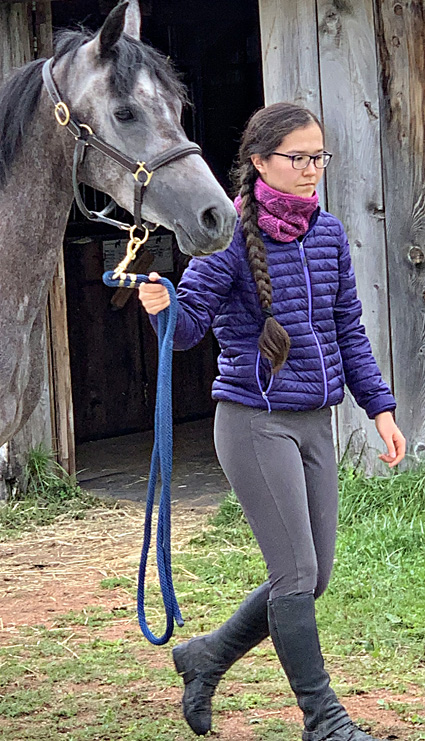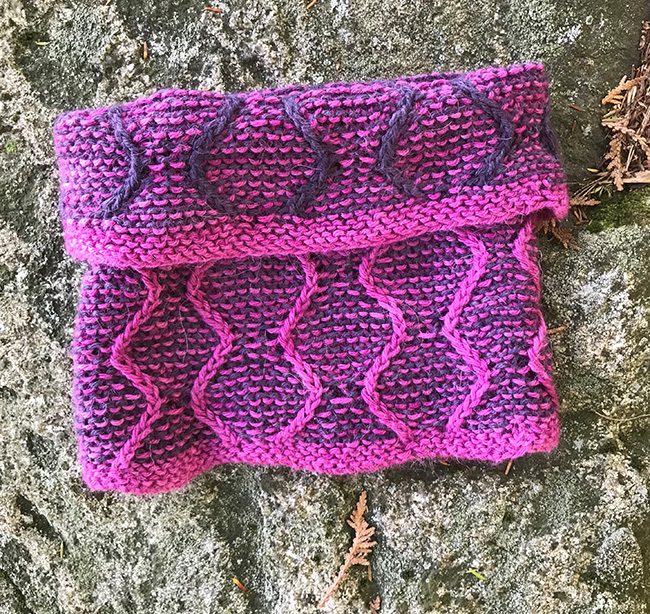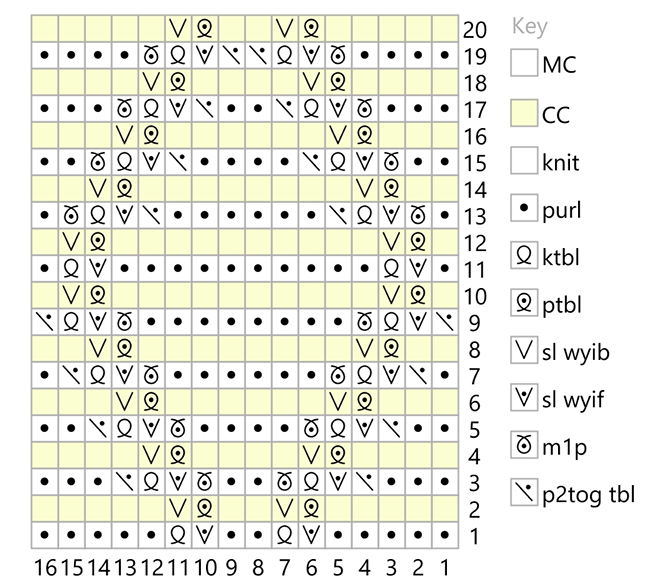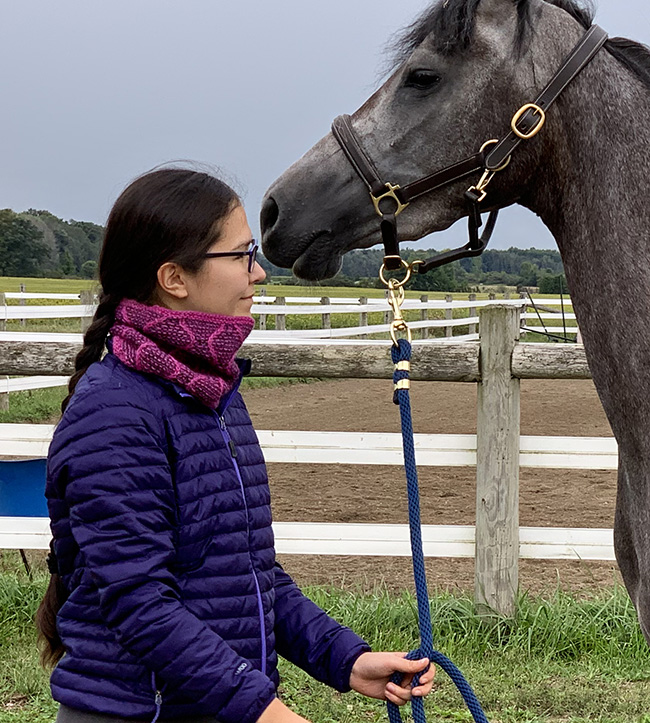Reversible Undulation Cowl, a free knitting pattern from Knitty.com. Free knitting pattern for a reversible cabled cowl in two colors.
INTRODUCTION
Reversible Undulation
 by Mary Martin
by Mary Martin
![]()
Cables take stitches and move them around in your knitting to create beautifully textured designs. I find knitting cables addictive as I am always anticipating where the cable will move to next. This cowl mimics the look and feel of cables using slipped stitches.
This cowl looks to have cables popping off of its 2-color garter stitch background, but these are really lines of slipped stitches that are shifted around with increases and decreases. The slipped stitches create texture by raising the stitch over the surface of the knitting. These slipped stitches are also applied to both sides of the fabric to make a completely reversible accessory.
The resultant fabric has the drape and feel of garter stitch but the lines are double thick creating extra squishiness. With different colored lines on each side, it feels like you have two different accessories and you don’t have to worry about putting it on with the right side showing. Or you can make a longer cowl to wrap around twice to show off both sides of the fabric at the same time.
Dive into your stash and try this new technique. You can make this cowl in any weight of yarn to any circumference and depth. Please see this page (Ravelry link) for help with choosing your yarn.
 model: Sarah Martin
model: Sarah Martin
 photos: Mary Martin
photos: Mary Martin
SIZE
One
FINISHED MEASUREMENTS
Circumference: 20 inches/ 51 cm
Height: 12 inches/30 cm
MATERIALS
Yarn
Blue Moon Fiber Arts Peru [50% alpaca, 30% merino, 20% silk; 500yd/ 457m per 8oz/ 226g skein]
![]() [MC]: Maroon Five; 1 skein
[MC]: Maroon Five; 1 skein
![]() [CC]: Smoke on Water; 1 skein
[CC]: Smoke on Water; 1 skein
Recommended needle size
[always use a needle size that gives you the gauge listed below - every knitter's gauge is unique]
![]() US #8/ 5mm circular needles 16 inch/ 40 cm.
US #8/ 5mm circular needles 16 inch/ 40 cm.
Note: You may also require a smaller needle for the cast off.
Notions
![]() stitch marker
stitch marker
![]() yarn needle
yarn needle

GAUGE
17 sts/ 26 rounds = 4 inches/10 cm in garter stitch
16 sts/ 28 rounds = 4 inches/ 10 cm in stocking stitch
Note: All measurements are taking after blocking.
PATTERN NOTES
[Knitty's list of standard abbreviations and techniques can be found here.]
Adjusting the Circumference:
The pattern is a repeat of 16 stitches. Cast on any multiple of 16 for your desired circumference. If you match the pattern gauge, each repeat will add 4" to the circumference.
CHARTS
Undulation Pattern
Work from chart or written instructions as you prefer.
Note: all odd-numbered rounds are worked in MC. All even-numbered rounds are worked in CC.
Round 1: P5, sl 1 wyif, k1 tbl, p2, sl 1 wyif, k1 tbl, p5.
Round 2: *K5, p1 tbl, sl wyib 1, k2, p1 tbl, sl wyib 1, k5.
Round 3: P3, p2togtbl, sl 1 wyif, k1 tbl, m1p, p2, m1p, sl 1 wyif, k1 tbl, p2togtbl, p3.
Round 4: (K4, p1 tbl, sl wyib 1) twice, k4.
Round 5: P2, p2togtbl, sl 1 wyif, k1 tbl, m1p, p4, m1p, sl 1 wyif, k1 tbl, p2togtbl, p2.
Round 6: K3, p1 tbl, sl wyib 1, k6, p1 tbl, sl wyib 1, k3.
Round 7: P1, p2togtbl, sl 1 wyif, k1 tbl, m1p, p6, m1p, sl 1 wyif, k1 tbl, p2togtbl, p1.
Round 8: K2, p1 tbl, sl wyib 1, k8, p1 tbl, sl wyib 1, k2.
Round 9: P2togtbl, sl 1 wyif, k1 tbl, m1p, p8, m1p, sl 1 wyif, k1 tbl, p2togtbl.
Round 10: K1, p1 tbl, sl wyib 1, k10, p1 tbl, sl wyib 1, k1.
Round 11: P1, sl 1 wyif, k1 tbl, p10, sl 1 wyif, k1 tbl, p1.
Round 12: K1, p1 tbl, sl wyib 1, k10, p1 tbl, sl wyib 1, k1.
Round 13: P1, m1p, sl 1 wyif, k1 tbl, p2togtbl, p6, p2togtbl, sl 1 wyif, k1 tbl, m1p, p1.
Round 14: K2, p1 tbl, sl wyib 1, k8, p1 tbl, sl wyib 1, k2.
Round 15: P2, m1p, sl 1 wyif, k1 tbl, p2togtbl, p4, p2togtbl, sl 1 wyif, k1 tbl, m1p, p2.
Round 16: K3, p1 tbl, sl wyib 1, k6, p1 tbl, sl wyib 1, k3.
Round 17: P3, m1p, sl 1 wyif, k1 tbl, p2togtbl, p2, p2togtbl, sl 1 wyif, k1 tbl, m1p, p3.
Round 18: (K4, p1 tbl, sl wyib 1) twice, k4.
Round 19: P4, m1p, sl 1 wyif, k1 tbl, p2tog tbl twice, sl 1 wyif, k1 tbl, m1p, p4.
Round 20: K5, p1 tbl, sl wyib 1, k2, p1 tbl, sl wyib 1, k5.

DIRECTIONS

Bottom Edge
With MC using a long-tail cast on, cast on 84 (or a multiple of 14) stitches. Place marker and join for working in the round being careful not to twist your stitches.
Knit one round.
Purl one round.
Knit one round.
Pattern setup round 1: With MC, *p5, k1 tbl, p2, k1 tbl, p5; repeat from * to end of round.
Join CC.
Pattern setup round 2: With CC, *k5, m1p, sl1 wyib, k2, m1p, sl1 wyib, k5; repeat from * to end of round. 96 st.
Body of Cowl
Starting with MC, work Undulation Pattern, working 16-stitch repeat 6 times around.
At the end of MC rounds, leave MC yarn at the front of your work. At the end of CC rounds leave CC yarn at back of work.
Continue, alternating colors (using MC for odd numbered rounds and CC for even numbered rounds) to chart round 20. Repeat Rounds 1- 20 three more times, or until the cowl reaches the desired length ending after Round 10 or 20.
Top Edge
Cut CC.
If you ended after Round 10, work a decrease round as follows: *p1, k2tog, p10, k2tog, p1; repeat from * to end of round. 84 sts.
OR
If you ended after Round 20, work a decrease round as follows: *p5, k2tog, p2, k2tog, p5; repeat from * to end of round. 84 sts.
Knit one round.
Purl one round.
Knit one round.
Bind off purlwise. If you find that your cast off looks too loose/sloppy, try using a smaller needle to cast off.
Cut yarn.

FINISHING
Block by soaking the cowl in cold water. Squeeze out all the excess water between some towels. Lay it out and smooth the fabric with your hand.
Weave in ends. Ends can be hidden between the two layers of cables.
ABOUT THE DESIGNER
 Mary Martin lives in Toronto, Canada, and has recently been fascinated by all the things that can be done with slipped stitches.
Mary Martin lives in Toronto, Canada, and has recently been fascinated by all the things that can be done with slipped stitches.
Mary studied engineering in university because she wanted to build things. She worked on Wall Street building and pricing financial instruments by breaking the products down into their component parts.
Mary thinks about knitting in the same way. There are some very well understood building blocks in knitting and Mary has so much fun to trying to combine them in different ways.
Find more of her designs here.
Pattern & images © 2020 Mary Martin.